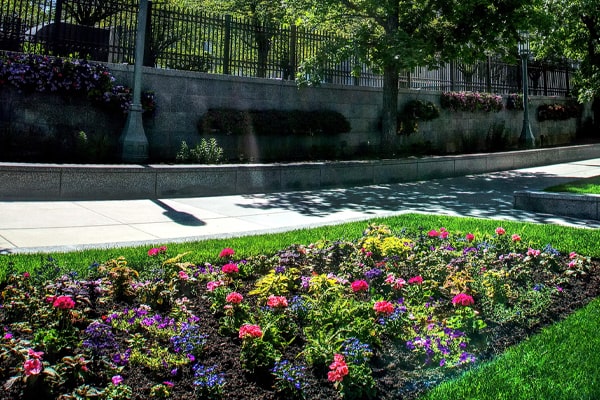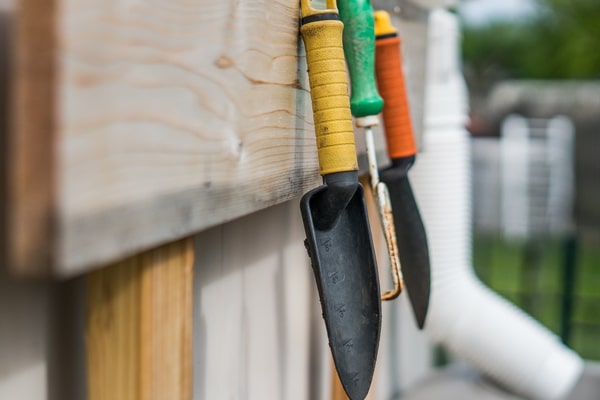Having a garden in an urban jungle is like having an oasis that can take you away from the hustle and bustle of city life. But maintaining one has its unique set of challenges.
How so?
In an urban setting, space is often limited. Gardens are surrounded by buildings and roads, which means weeds can quickly take over. These unwanted plants compete with the desired ones for sunlight, water, and nutrients, hindering their growth.
Additionally, urban environments often have polluted soil, which can encourage weed growth while making it harder for desired plants to thrive.
Because urban gardens are frequently accessible to many people, they may face more foot traffic, leading to soil compaction, which can also lead to weed growth.
While urban gardening can be rewarding, dealing with weeds is a constant challenge that requires regular maintenance. In this guide, we are outlining the unique challenges of weed management in urban settings and how to overcome them:
Contents []
6 Challenges and Solutions in Maintaining a Weed-Free Urban Garden

Weed control in urban gardens can be a challenging task due to limited space, competing plant species, and the presence of hard surfaces like concrete and pavement. Here are some common challenges faced by urban gardeners and their solutions.
Not Knowing the Enemy
Unlike rural areas where familiar weeds are easier to identify, urban environments host a wide variety of plant species, including both native plants and invasive weeds.
City gardeners might struggle to identify which plants are beneficial and which are harmful. Also, urban gardens often have diverse sources of seeds, including wind-blown seeds from nearby parks or green spaces, making it difficult to anticipate which weeds might sprout in the garden.
Being proactive is essential to identify weeds, especially if you’re new to gardening.
To control weeds, you need to:
- Learn about different invasive plants that could possibly grow in your garden.
- Prevent weed seeds from entering their gardens by using mulch or weed barriers to block them.
- Regularly inspecting the garden for new growth and promptly removing any unfamiliar plants can help prevent weeds from establishing themselves.
- Maintain healthy soil by adding organic matter and using proper watering techniques, as healthy plants are better equipped to compete with weeds.
If you can’t identify weeds at all, we suggest joining local gardening communities or extension services to learn more about common weeds in their area and how to identify them. These places might have community gardening programs where experienced gardeners can provide valuable advice and support.
Not investing in the right weeding tools

Without investing in proper weeding tools, controlling weeds effectively becomes more challenging and tiresome. What tools to buy for your urban garden? Here are the basic tools that’ll come in handy:
- Hand trowels are handy for removing small weeds with shallow roots. It’s also useful in tilling the soil in container gardens, which can help prevent weeds from going to seed.
- Hoes are useful for tackling larger areas or breaking up compacted soil where weeds thrive. It’s a great tool for tilling the soil and pulling weeds with very deep root systems.
- Weed pullers, like dandelion diggers or long-handled weed extractors, are particularly helpful for removing weeds with deep taproots, ensuring they’re extracted entirely to prevent regrowth.
- Ergonomic and durable tools can make the weeding process more comfortable and efficient. Look for tools with padded handles or adjustable lengths to reduce strain on your hands and back during long periods of use.
It’s vital to invest in basic weeding tools before building a gardenThis way, you have the right equipment before weeds even sprout. These tools are also versatile because they can be used in various ways, which will save you money.
Dealing with Pests and Pollution
Pollution, such as air and soil contamination from vehicle emissions, industrial activities, and chemical runoffs, can negatively impact plants, desired or otherwise.
The same thing goes for pests – nibbling insects and rodents are attracted to urban settings and it’s only a matter of time before they overtake the garden. A pest-ridden garden can easily lead to weed proliferation by spreading seeds and damaging plants.
To solve these problems, you’ll need to be strategic:
- Prioritize soil health by regularly adding organic matter, such as compost, to improve soil structure and fertility. Healthy soil fosters robust plant growth, making it easier for desired plants to outcompete weeds.
- Choosing native or adapted plant species that are resilient to urban conditions can help minimize weed infestations and reduce the need for chemical pesticides. Native plants are better suited to local environmental conditions and often require less maintenance.
- Implementing integrated pest management (IPM) techniques can help control pests without relying on harmful chemicals. This approach involves using a combination of cultural, biological, and mechanical methods, such as introducing beneficial insects, installing physical barriers, and practicing proper sanitation, to manage pest populations effectively.
- Maintaining a clean and tidy garden by promptly removing weeds, debris, and standing water can help deter pests and reduce weed growth. Regular monitoring of the garden for signs of pollution-related stress or pest damage allows for early intervention and mitigation.
Limited Access to Water Sources

Water scarcity, combined with increasing demands for water in densely populated areas, can make it difficult to maintain gardens while also controlling weed growth. Here are some tips to hydrate the garden and keep weeds in check:
- Utilize water-efficient irrigation methods such as drip irrigation or soaker hoses. These systems deliver water directly to the plant roots, minimizing evaporation and water waste.
- Apply a layer of mulch, such as wood chips or straw, to the soil surface. Mulch helps retain soil moisture, reducing the frequency of watering while also suppressing weed growth by blocking sunlight and preventing weed seeds from germinating.
- Choose plant varieties that are well-adapted to dry conditions. Native plants or species known for their drought tolerance require less water, helping to conserve limited water resources in urban environments.
- Schedule weed management activities during cooler times of the day to minimize water loss through evaporation. Weeding after rainfall or irrigation when the soil is already moist makes it easier to remove weeds while minimizing water usage.
- Install rain barrels or cisterns to collect rainwater from rooftops. This harvested rainwater can then be used for garden irrigation, reducing reliance on municipal water sources. Just make sure to check with your landlord if collecting rainwater is allowed if you live in a condo or apartment.
Limited Outdoor Space
While it’s possible to create a beautiful garden even in the smallest of spaces, it can be hard to find ways to make every inch of a tiny space work. That means the limited space also makes it difficult to control weeds effectively. But there are strategies to overcome this challenge, such as:
- Use vertical space by growing plants upwards on trellises, walls, or vertical garden structures. Vertical gardening maximizes growing area while minimizing ground space where weeds can proliferate.
- Grow plants in containers or raised beds to optimize space usage. Containers can be placed on balconies, patios, or rooftops, allowing for gardening in small or unconventional spaces while reducing weed encroachment from surrounding areas.
- Practice intensive planting techniques, such as square foot gardening or interplanting, to maximize yield in limited space. By densely planting crops, there’s less room for weeds to establish themselves, reducing the need for extensive weeding.
- Apply mulch to suppress weed growth and conserve moisture in bare soil areas. Mulch inhibits weed seed germination by blocking sunlight.
- Grow ground cover plants to suffocate weeds and prevent weed seeds from germinating. Ground cover plants create a dense mat that shades the soil and outcompetes weeds for resources.
Finally, don’t forget to weed, prune and thin out plants to prevent weeds from taking over. Promptly removing weeds as soon as they appear helps maintain a tidy and weed-free garden space.
Procrastinating
With busy lifestyles and competing demands for time, it can be difficult to prioritize consistent upkeep, allowing weeds to quickly take over. This can be avoided by:
- Setting a maintenance schedule and sticking to it. Dedicate specific times each week for tasks such as weeding, watering, and pruning. Consistency is key to staying ahead of weed growth and maintaining a healthy garden environment.
- Break maintenance tasks into smaller, manageable chunks to avoid feeling overwhelmed. Focus on one area of the garden at a time, gradually working your way through the entire space. Starting small makes it easier to stay motivated and maintain regular upkeep.
- Invest in quality gardening tools and equipment to make maintenance tasks more efficient. Hand trowels, hoes, and weed pullers can help streamline the weeding process, while watering cans or hoses with adjustable nozzles ensure proper hydration for plants without wasting water.
- Apply mulch or ground cover plants to suppress weed growth and reduce the need for frequent weeding. Mulch helps retain soil moisture and inhibits weed seed germination, while ground cover plants create a dense mat that shades the soil and outcompetes weeds for resources. You can also use weed barrier landscape fabric as an alternative to organic mulch.
- Regularly inspect the garden for signs of weed growth, pest infestations, or other issues that require attention. Early detection allows for prompt intervention, preventing problems from escalating and maintaining a healthy garden ecosystem.
Gardening takes serious commitment. Don’t procrastinate, and ensure consistent upkeep to keep your garden tidy and healthy.



